As They Grow: Books for Beginning Readers of Any Age
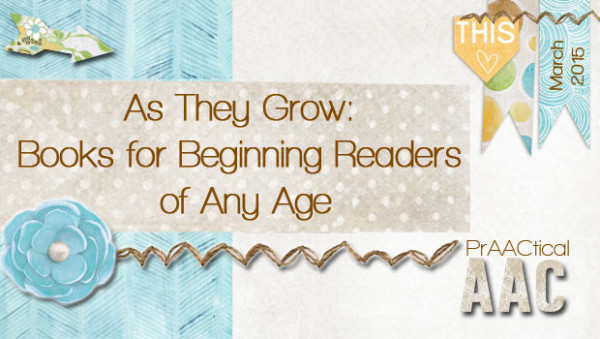
Like many of you, I’m always on the hunt for ways to support beginning communicators who are also learning to read. As SLPs, we have a huge opportunity to advocate 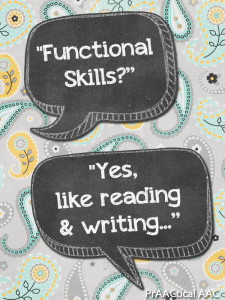 for and provide good literacy learning opportunities for individuals with AAC needs. For learners past the preschool age, it can be challenging to find material that engages them and yet respects the fact that they are no longer young children. Last month, we share a handout from a wonderful ATIA presentation that Drs. Hanser and Musselwhite did on this topic (you can see that post here).
for and provide good literacy learning opportunities for individuals with AAC needs. For learners past the preschool age, it can be challenging to find material that engages them and yet respects the fact that they are no longer young children. Last month, we share a handout from a wonderful ATIA presentation that Drs. Hanser and Musselwhite did on this topic (you can see that post here).
Today, I’m sharing the thoughts of Erin Sheldon, whose work in inclusive education for students with significant disabilities and support of families with Angelman Syndrome (AS) is known to many of you. Erin’s work is directly informed by her daughter Maggie, who has AS and is fully included in her general education classroom. A version of this appeared in the Facebook group, Angelman, Literacy, and Education.
Age-considerate Books for Older Students
One of the most important reasons to be very proactive finding age-considerate texts is that many of these kids can spend 10+ years at a very emergent level. If we stick with easy texts intended for young children, they will be stuck with the same texts for a LONG time. They need access to a broad range of books in order to find books that appeal to them and that inspire them to want to read and write. Books for young children often fail to represent many genre of text.
Another consideration relates to the illustrations in books for young children. Many early children’s books are visually very busy. Photos can be harder to process visually than simple line drawings. Just because a book is for younger kids, doesn’t mean it is more accessible or easier to process.
“Can we EVER use books for younger children with AAC learners who are a bit older?”
Sure. If students have favourite texts that are for younger kids, I encourage their families to keep those at home, just as all kids would hold on to relics from younger childhood. It is typical for kids to revisit beloved texts from early childhood but consider saving them for home, or to anchor a learning experience for older kids, not as the feature text itself. For example, if we’re studying turtles, go ahead and review what we know about turtles from some early childhood books, to remind kids of what they have read in the past.
We CAN find age-considerate texts for older students who are beginning readers and writers! Here are some suggestions:
- Tar Heel Reader. Find books and exemplar texts here. In a recent workshop, we spent a lot of time on the texts written by Jane Farrall, the Dynamic Learning Map
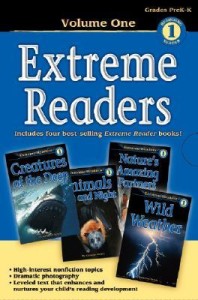 (DLM) Consortium, and Alison Rumball (click on their names to see books that they’ve authored). If you work with teens, search for books by Reed A. Booke, but check the settings (E=Everyone; C=Caution) for content appropriate for your learner. In TarHeel Reader, you will find many levels of texts. An added bonus: You can edit and adapt the text further in PowerPoint. New to TarHeel Reader? Here’s a quick tutorial.
(DLM) Consortium, and Alison Rumball (click on their names to see books that they’ve authored). If you work with teens, search for books by Reed A. Booke, but check the settings (E=Everyone; C=Caution) for content appropriate for your learner. In TarHeel Reader, you will find many levels of texts. An added bonus: You can edit and adapt the text further in PowerPoint. New to TarHeel Reader? Here’s a quick tutorial. - The Start to Finish Literacy Starters from Don Johnston and the Learning to Work series from Attainment are both excellent. They can serve as exemplar texts to help you recognize the multiple levels of text that all students need access to. These are early texts written for older students.
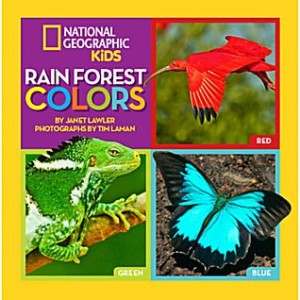
- There are some great non-fiction series put out by Scholastic authored by National Geographic, the BBC, and several other good sources. They address beginning readers with real photos in non-fiction informational texts. They are age-considerate for a broad range of ages, and are often organized for phonics instruction. These are distributed by Scholastic every fall in their kindergarten and preschool book catalogs, and sporadically throughout the year.
- There is a huge range of amazing alphabet books out there that are totally appropriate across many ages. We make alphabet books for anything we are studying at school, as a place to organize vocabulary specific to a new unit.
- Animal life cycles: B is for butterfly, C Is for caterpillar, E is for egg.
- Ancient Egypt: A is for ancient, C is for canopic jars and cats and Cleopatra, P is for pyramids.
- Settlers: B is for birchbark, C is for cabin and canoe, P is for pioneers.
- Gretchen Hanser’s PowerPoint book templates at the Center for Literacy and Disability Studies site make this very easy.
- Dr. Seuss and Shel Silverstein are age-considerate for everybody! Caroline Musselwhite has a ton of resources on using poetry with older students.
- DK Books has a bunch of visually uncluttered books with real photos on non-fiction topics.
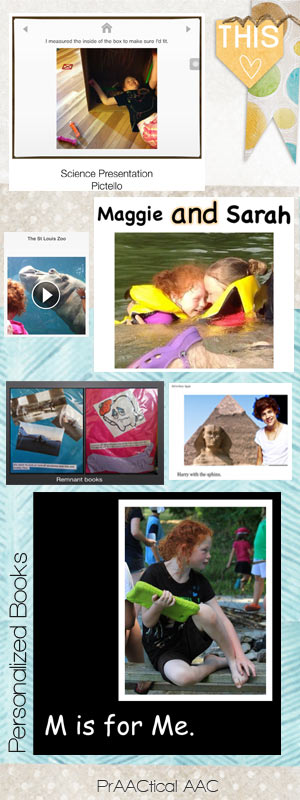
- Many of our kids respond to highly personalized homemade books. My daughter Maggie’s sight word books all feature her friends and personal interests. We are trying to show her that abstract sight words can be anchored in her own personal experience. She loves these books. I’ve also taken the text out of books but replaced the childish illustrations with real photos to make them more age-considerate. Alison Rumball, for example, has re-written Brown Bear, What Do You See? on Tar Heel Reader, with the theme of each province of Canada (“Alberta, Alberta, What do you see?”). We made a Brown Bear, Brown Bear book of Maggie, her friends, and the boys from One Direction. “Maggie, Maggie, what do you see? I see Liam looking at me! Liam, Liam, what do you see? I see Maisy looking at me!”
- Many teachers use predictable chart writing (PCW) as part of their literacy curriculum. In some classrooms, PCW results in weekly personalized homemade books. The books can be polished and “published”, illustrated with photos found off the web or of the kids themselves, and these are highly accessible, readable early iBooks for the kids who helped author them.
- The Unique Learning System Curriculum also has a library of books. I would avoid any of the books with symbol-supported text but there are tons of great letter books and a wide range of simple books. Maggie enjoys seeing her familiar symbols used as illustrations, such as the illustration for camping be a familiar “girl” symbol with a tent and owl. Not all of the books are captivating, but many are quite good and have been levelled already. As long as you don’t limit students to a single level, but use a range of levels for a range of purposes, this can be a good resource.
“But what if an older student REALLY likes an early childhood book?”
If you really like some younger kids books, then another option is to have a purpose for reading specific to younger children. I was recently with a team where they had the students practice reading younger kids’ books so they could read them to their kindergarten reading buddies. They needed to practice how to read them with AAC devices or in Pictello so they could fluently read them to their buddies. They were doing PCW to write books for kindergarteners. They took the books “That’s Disgusting!” and “That’s Dangerous!” and created their own version that they read to kindergartners.
We can also use younger characters as an entree to bigger ideas. If students love Dora, then expand that to study Mexico and Spanish. We can make an ABC book about Dora to share with younger kids. We can make informational texts describing Dora: Dora is…, Dora likes…, Dora goes…. The app Kid in Story Creator is fun to add characters or kids to any text to brighten non-fiction topics with a beloved or familiar character.
Consider taking the theme of preschool books and using that for older students in creative ways. A student who loves Frankin can expand that to reading about turtles and animal conservation. A student who loves Thomas books can expand that to learning about trains and transportation. A student who loves Barney can expand that to dinosaurs and musical theatre. The Wiggles are a great launching point for musical theatre. Doing this allows us to help kids expand their interests, using their personal interests to anchor bigger ideas and deeper learning and engagement.
Do you have favorite ways of addressing the emergent literacy needs of older students? We’d love to hear about things that have worked for you.

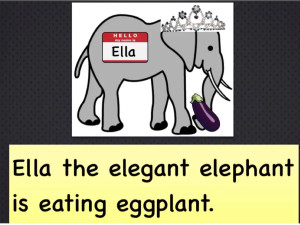
Filed under: PrAACtical Thinking
Tagged With: age appropriate, age respectful, angelman syndrome, Books, Erin Sheldon, literacy, older students, reading
This post was written by Carole Zangari


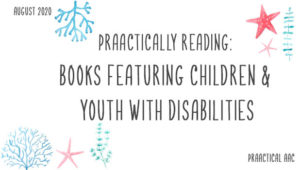

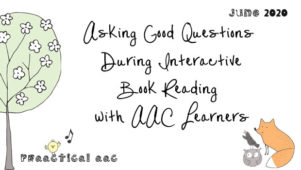
4 Comments
You said not to use symbol supported texts. Is there a reason why and if so what is the reason? I re-write my students’ books with the sequences on their devices so they learn to read with their devices. Do you view this in the same manner as symbolstix in ULS?
Gayle, I don’t know if Erin is monitoring this, so I will respond to share my own thoughts. It really depends on what your goals are. Symbol-supported text tends to cause learners to focus on the symbols, and not the actual text. That makes it more difficult for them to learn to read in a conventional sense. Having the text alone, even if the book is read aloud to them, keeps the focus on print and that supports development of reading skills. Hope that makes sense.
Thanks, Carole. That makes tons of sense!
I couldn’t refrain from commenting. Exceptionally well written!